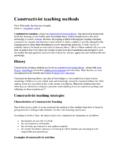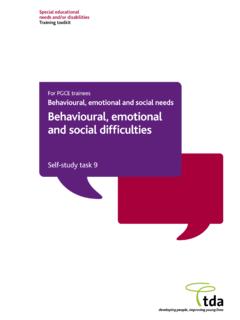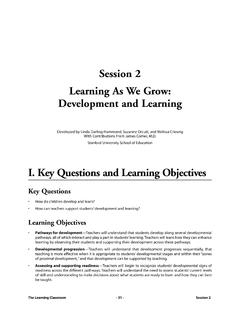Transcription of Constructivism (learning theory) - Teacher education
1 Constructivism ( learning theory ). From Wikipedia, the free encyclopedia Constructivism is a theory of knowledge (epistemology)[1]. that argues that humans generate knowledge and meaning from an interaction between their experiences and their ideas. During infancy, it is an interaction between their experiences and their reflexes or behavior-patterns. Piaget called these systems of knowledge schemata. Constructivism is not a specific pedagogy, although it is often confused with constructionism, an educational theory developed by Seymour Papert, inspired by constructivist and experiential learning ideas of Jean Piaget. Piaget's theory of constructivist learning has had wide ranging impact on learning theories and teaching methods in education and is an underlying theme of many education reform movements. Research support for constructivist teaching techniques has been mixed, with some research supporting these techniques and other research contradicting those results.
2 History In past centuries, constructivist ideas were not widely valued due to the perception that children's play was seen as aimless and of little importance. Jean Piaget did not agree with these traditional views, however. He saw play as an important and necessary part of the student's cognitive development and provided scientific evidence for his views. Today, constructivist theories are influential throughout much of the non-formal learning sector. One good example of constructivist learning in a non-formal setting is the Investigate Centre at The Natural History Museum, London. Here visitors are encouraged to explore a collection of real natural history specimens, to practice some scientific skills and make discoveries for themselves. Writers who influenced Constructivism include: John Dewey (1859 1952). Maria Montessori (1870 1952). W adys aw Strzemi ski (1893 1952). Jean Piaget (1896 1980). Lev Vygotsky (1896 1934).
3 Heinz von Foerster (1911 2002). Jerome Bruner (1915-). Herbert Simon (1916 2001). Paul Watzlawick (1921 2007). Ernst von Glasersfeld (1917 2010). Edgar Morin (1921-). For more detailed information on the philosophy of the construction of human knowledge, see constructivist epistemology. Constructivist theory Formalization of the theory of Constructivism is generally attributed to Jean Piaget, who articulated mechanisms by which knowledge is internalized by learners. He suggested that through processes of accommodation and assimilation, individuals construct new knowledge from their experiences. When individuals assimilate, they incorporate the new experience into an already existing framework without changing that framework. This may occur when individuals'. experiences are aligned with their internal representations of the world, but may also occur as a failure to change a faulty understanding; for example, they may not notice events, may misunderstand input from others, or may decide that an event is a fluke and is therefore unimportant as information about the world.
4 In contrast, when individuals' experiences contradict their internal representations, they may change their perceptions of the experiences to fit their internal representations. According to the theory , accommodation is the process of reframing one's mental representation of the external world to fit new experiences. Accommodation can be understood as the mechanism by which failure leads to learning : when we act on the expectation that the world operates in one way and it violates our expectations, we often fail, but by accommodating this new experience and reframing our model of the way the world works, we learn from the experience of failure, or others' failure. It is important to note that Constructivism is not a particular pedagogy. In fact, Constructivism is a theory describing how learning happens, regardless of whether learners are using their experiences to understand a lecture or following the instructions for building a model airplane.
5 In both cases, the theory of Constructivism suggests that learners construct knowledge out of their experiences. However, Constructivism is often associated with pedagogic approaches that promote active learning , or learning by doing. There are many critics of " learning by doing" ( "discovery learning ") as an instructional strategy ( see the criticisms below).[2][3] While there is much enthusiasm for Constructivism as an design strategy, according to Tobias and Duffy ".. to us it would appear that Constructivism remains more of a philosophical framework than a theory that either allows us to precisely describe instruction or prescribe design strategies.( )".[2] This is unfortunate because there is quite a bit of promise to the educational philosophy behind Constructivism , but constructivists seem to be having difficulties defining testable learning theories. In part this is due to Piaget's distrust of empirical methods and reliance upon the clinical method.
6 Constructivist learning intervention The nature of the learner The learner as a unique individual Social Constructivism views each learner as a unique individual with unique needs and backgrounds. The learner is also seen as complex and multidimensional. Social Constructivism not only acknowledges the uniqueness and complexity of the learner, but actually encourages, utilizes and rewards it as an integral part of the learning process (Wertsch 1997). The importance of the background and culture of the learner Social Constructivism or socioculturalism encourages the learner to arrive at his or her version of the truth, influenced by his or her background, culture or embedded worldview. Historical developments and symbol systems, such as language, logic, and mathematical systems, are inherited by the learner as a member of a particular culture and these are learned throughout the learner's life. This also stresses the importance of the nature of the learner's social interaction with knowledgeable members of the society.
7 Without the social interaction with other more knowledgeable people, it is impossible to acquire social meaning of important symbol systems and learn how to utilize them. Young children develop their thinking abilities by interacting with other children, adults and the physical world. From the social constructivist viewpoint, it is thus important to take into account the background and culture of the learner throughout the learning process, as this background also helps to shape the knowledge and truth that the learner creates, discovers and attains in the learning process (Wertsch 1997). The responsibility for learning Furthermore, it is argued that the responsibility of learning should reside increasingly with the learner (Glasersfeld, 1989). Social Constructivism thus emphasizes the importance of the learner being actively involved in the learning process, unlike previous educational viewpoints where the responsibility rested with the instructor to teach and where the learner played a passive, receptive role.
8 Von Glasersfeld (1989) emphasized that learners construct their own understanding and that they do not simply mirror and reflect what they read. Learners look for meaning and will try to find regularity and order in the events of the world even in the absence of full or complete information. The Harkness Discussion Method It is called the "Harkness" discussion method because it was developed at Phillips Exeter Academy with funds donated in the 1930s by Edward Harkness. It involves students seated in a circle, motivating and controlling their own discussion. The Teacher acts as little as possible. Perhaps the Teacher 's only function is to observe, although he/she might begin or shift or even direct a discussion. The students get it rolling, direct it, and focus it. They act as a team, cooperatively, to make it work. They all participate, but not in a competitive way. Rather, they all share in the responsibility and the goals, much as any members share in any team sport.
9 Although the goals of any discussion will change depending upon what's under discussion, some goals will always be the same: to illuminate the subject, to unravel its mysteries, to interpret and share and learn from other points of view, to piece together the puzzle using everyone's contribution. Discussion skills are important. Everyone must be aware of how to get this discussion rolling and keep it rolling and interesting. Just as in any sport, a number of skills are necessary to work on and use at appropriate times. Everyone is expected to contribute by using these skills. The motivation for learning Another crucial assumption regarding the nature of the learner concerns the level and source of motivation for learning . According to Von Glasersfeld (1989) sustaining motivation to learn is strongly dependent on the learner's confidence in his or her potential for learning . These feelings of competence and belief in potential to solve new problems, are derived from first-hand experience of mastery of problems in the past and are much more powerful than any external acknowledgment and motivation (Prawat and Floden 1994).
10 This links up with Vygotsky's "zone of proximal development" (Vygotsky 1978) where learners are challenged within close proximity to, yet slightly above, their current level of development. By experiencing the successful completion of challenging tasks, learners gain confidence and motivation to embark on more complex challenges. The role of the instructor Instructors as facilitators According to the social constructivist approach, instructors have to adapt to the role of facilitators and not teachers (Bauersfeld, 1995). Whereas a Teacher gives a didactic lecture that covers the subject matter, a facilitator helps the learner to get to his or her own understanding of the content. In the former scenario the learner plays a passive role and in the latter scenario the learner plays an active role in the learning process. The emphasis thus turns away from the instructor and the content, and towards the learner (Gamoran, Secada, & Marrett, 1998).







